Two-Block Problems
Two-Block Problems: Overview
This topic covers concepts, such as, Motion of Two Blocks on Horizontal Plane, Motion of Two Blocks on Inclined Plane, Condition for Relative Motion between Two Blocks & Motion of Two Blocks in Contact etc.
Important Questions on Two-Block Problems
Two blocks connected by a massless string slide down an inclined plane having an angle of inclination of The masses of the two blocks are and respectively and the coefficients of friction of and with the inclined plane are 0.75 and 0.25 respectively. Assuming the string to the taut, find the tension in the string.
Two blocks connected by a massless string slide down an inclined plane having an angle of inclination of The masses of the two blocks are and respectively and the coefficients of friction of and with the inclined plane are and respectively. Assuming the string to be taut, find the common acceleration of two masses.
Two blocks of masses and are placed on a horizontal surface as shown in fig. The coefficient of friction between the blocks is and that between the block and the horizontal surface is . What is the maximum horizontal force that can be applied to block so that the two blocks move without slipping ? Take
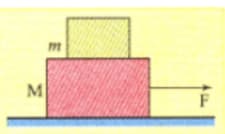
Blocks and are arranged as shown in the figure. The pulley is frictionless. The mass of is . The coefficient of friction between the block and the horizontal surface is . The minimum mass of , to start the motion, will be
A block of mass is placed on a plank of mass which is placed on a smooth horizontal plane, as shown in the figure. The coefficient of friction between the block and the plank is If a horizontal force is applied on the plank, then the maximum value of for which the block and the plank move together is
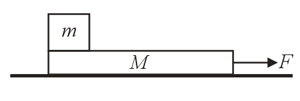
In the arrangement shown in the figure, if the blocks of masses and are released from the state of rest, tension in the string is ( coefficient of friction, string is massless and inextensible, pulley is frictionless)
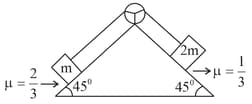
In the situation shown, the reading of the spring balance is

The system is pushed by the force as shown. All surfaces are smooth except between and . Friction coefficient between and is Minimum value of to prevent block from downward slipping is

Two blocks are placed on a wedge with coefficients of friction being different for two blocks. Choose the correct option. (friction is not sufficient to prevent the motion)
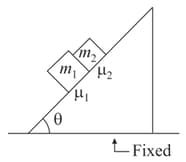
Two blocks of mass and are pushed along a horizontal frictionless surface by a force of applied to the block at an angle of to the horizontal. The force that the block exerts on the block is
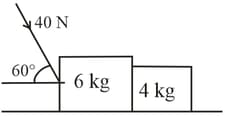
If acceleration of is which is smaller than acceleration of then the value of frictional force applied by on is :
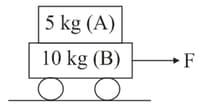
The friction coefficient between the table and the block shown in figure is . Find the tension in the string which is connected with both blocks.
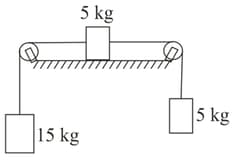
coefficient of friction between two blocks and of masses and respectively is and horizontal floor is frictionless as shown in the given figure. If is pulled to right by through then work done by the force of friction on is

Block 1 sits on top of block . Both of them have a mass of . The coefficients of friction between blocks and are and . The table is frictionless. A force is applied on block to the left, and force on block to the right. Obtain the minimum value of such that both blocks move relative to each other and fill in OMR.

Initially the whole system is at rest and now a force of is applied on the block '' as shown in the figure. Find the time taken by '' (in ) to fall from the block '' :-

If force is applied to block as shown in diagram then maximum value of so that there is no relative motion between the blocks.

Calculate the accelerations of the blocks and

The friction coefficient between the blocks is The acceleration of each block is :-

A force of is applied on the upper block as shown in figure. The coefficient of static friction between the two blocks is and that between the lower block and the surface is zero. The work done by the lower block on the upper block for a displacement of of the upper block is :-

In friction is present between only and limiting friction between . Find acceleration of


